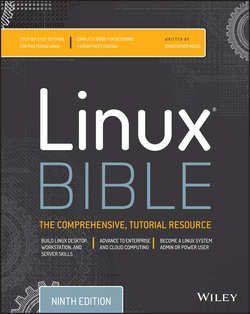Читать книгу Linux Bible - Christopher Negus - Страница 16
На сайте Литреса книга снята с продажи.
Part II
Becoming a Linux Power User
Chapter 3
Using the Shell
ОглавлениеBefore icons and windows took over computer screens, you typed commands to interact with most computers. On UNIX systems, from which Linux was derived, the program used to interpret and manage commands was referred to as the shell.
No matter which Linux distribution you are using, you can always count on the fact that the shell is available to you. It provides a way to create executable script files, run programs, work with filesystems, compile computer code, and manage the computer. Although the shell is less intuitive than common graphic user interfaces (GUIs), most Linux experts consider the shell to be much more powerful than GUIs. Shells have been around a long time, and many advanced features that aren't available from the desktop can be accessed by running shell commands.
The Linux shell illustrated in this chapter is called the bash shell, which stands for Bourne Again Shell. The name is derived from the fact that bash is compatible with the one of the earliest UNIX shells: the Bourne shell (named after its creator Stephen Bourne, and represented by the sh command).
Although bash is included with most distributions, and considered a standard, other shells are available, including the C shell (csh), which is popular among BSD UNIX users, and the Korn shell (ksh), which is popular among UNIX System V users. Ubuntu uses the dash shell, by default, which is designed to perform faster than the bash shell. Linux also has a tcsh shell (an improved C shell) and an ash shell (another Bourne shell look-alike).
The odds are strong that the Linux distribution you are using has more than one shell installed by default and available for your use. This chapter, however, focuses primarily on the bash shell. That is because the Linux distributions featured in this book, Fedora and Red Hat Enterprise Linux, both use the bash shell by default. The bash shell can also easily be added to Ubuntu.
The following are a few major reasons to learn how to use the shell:
● You will know how to get around any Linux or other UNIX-like system. For example, I can log in to my Red Hat Enterprise Linux web server, my home multimedia server, my home router, or my wife's Mac and explore and use any of those computer systems from a shell. I can even log in and run commands on my Android phone. They all run Linux or similar systems on the inside.
● Special shell features enable you to gather data input and direct data output between commands and the Linux filesystem. To save typing, you can find, edit, and repeat commands from your shell history. Many power users hardly touch a graphical interface, doing most of their work from a shell.
● You can gather commands into a file using programming constructs such as conditional tests, loops, and case statements to quickly do complex operations that would be difficult to retype over and over. Programs consisting of commands that are stored and run from a file are referred to as shell scripts. Most Linux system administrators use shell scripts to automate tasks such as backing up data, monitoring log files, or checking system health.
The shell is a command language interpreter. If you have used Microsoft operating systems, you'll see that using a shell in Linux is similar to – but generally much more powerful than – the interpreter used to run commands in DOS or in the CMD command interface. You can happily use Linux from a graphical desktop interface, but as you grow into Linux you will surely need to use the shell at some point to track down a problem or administer some features.
How to use the shell isn't obvious at first, but with the right help you can quickly learn many of the most important shell features. This chapter is your guide to working with the Linux system commands, processes, and filesystem from the shell. It describes the shell environment and helps you tailor it to your needs.
